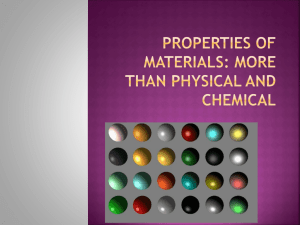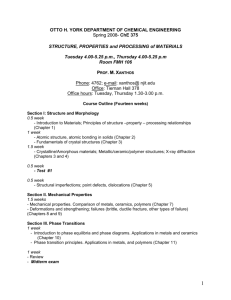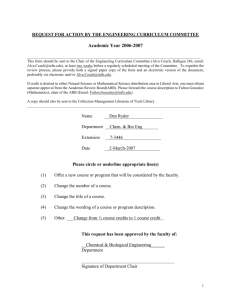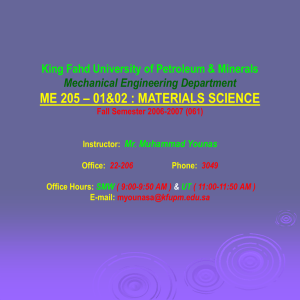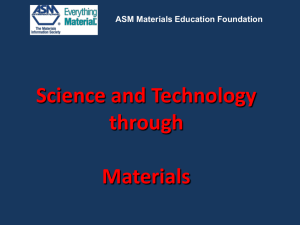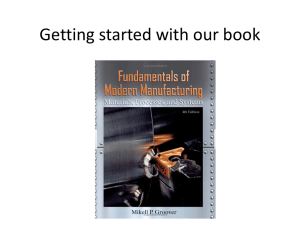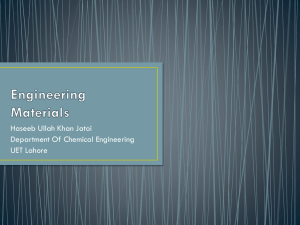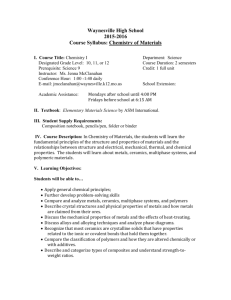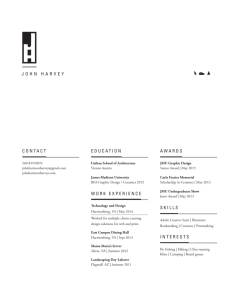File
advertisement
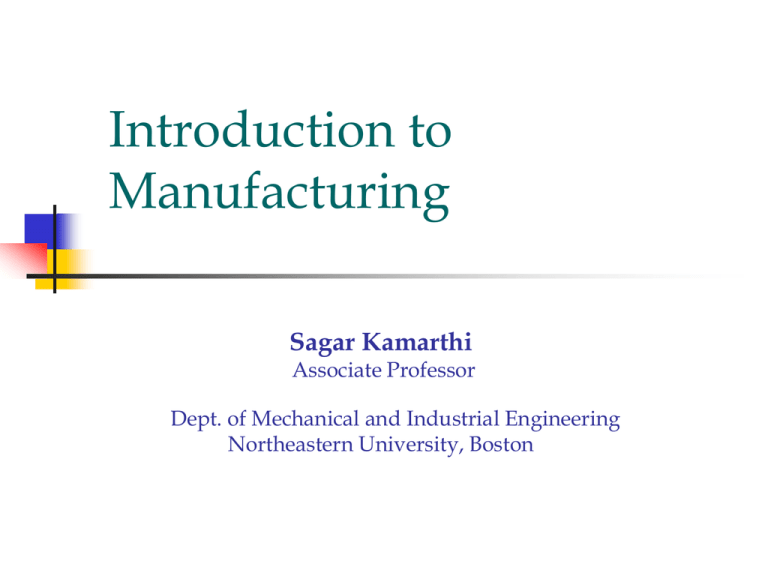
Introduction to Manufacturing Sagar Kamarthi Associate Professor Dept. of Mechanical and Industrial Engineering Northeastern University, Boston Topics • Product life cycle • Manufacturing • Building blocks of manufacturing Product Life Cycle Product Life Cycle Product Life Cycle Design Part of Product Life Cycle Mfg Part of Life Cycle Topics • Product life cycle • Manufacturing • Building blocks of manufacturing Manufacturing • Manufacturing is the application of physical and chemical processes to alter the geometry, properties, and/or appearance of a given starting material • To make parts or products, or • To join multiple parts to make assembled products • Manufacturing adds value to the material • When iron ore is converted to steel, value is added • When sand is transformed into glass, value is added • When crude oil is refined into petrol (gasoline), value is added Manufacturing Process Manufacturing Adds Value Building Blocks of Manufacturing • Materials • Manufacturing processes • Assembly operations • Manufacturing Automation Materials • Most engineering materials can be classified into one of four basic categories: 1. 2. 3. 4. Metals Ceramics Polymers Composites • Mechanical, physical and chemical properties these type of materials are different • These differences affect the manufacturing processes that can be used to produce products from them Metals • Metals are usually alloys, which are composed of two or more elements, at least one of which is metallic • Two basic groups of metals/alloys are: 1. 2. Ferrous metals are based on iron Comprises about 75% of metal tonnage in the world Steel = Fe-C alloy (0.02 to 2.11% C) Cast iron = Fe-C alloy (2% to 4% C) Nonferrous metals are metallic elements and their alloys of aluminum, copper, magnesium, nickel, silver, tin, titanium, etc. Ceramics • Compounds containing metallic (or semi-metallic) and nonmetallic elements. • Typical nonmetallic elements are oxygen, nitrogen, and carbon • For processing, ceramics divide into: 1. Crystalline ceramics Traditional ceramics, such as clay (hydrous aluminum silicates) Modern ceramics, such as alumina (Al2O3) Glasses 2. Mostly based on silica (SiO2) Polymers • Thermoplastic polymers • • Thermosetting polymers • • They can be subjected to multiple heating and cooling cycles without altering their molecular structure They cannot be reheated because molecules are chemically transformed (cured) into a rigid structure Elastomers • They shows significant elastic behavior Composites • Nonhomogeneous mixtures of basic materials Manufacturing Processes • Material removal processes • Starting material is a ductile or brittle solid • Solidification processes • Starting material is a heated liquid or semi-fluid • Particulate processing • Starting material consists of powders • Deformation processes • Starting material is a ductile solid (commonly metal) Material Removal Processes • Excess material removed from the starting piece so what remains is the desired geometry • Examples: machining such as turning, drilling, and milling, grinding, laser cutting Material Removal Processes Metal chips fly in a high speed turning operation performed on a computer numerical control turning center (photo courtesy of Cincinnati Milacron). ©2007 John Wiley & Sons, Inc. M P Groover, Fundamentals of Modern Manufacturing 3/e Solidification Processes • Starting material is heated sufficiently to transform it into a liquid or highly plastic state • Examples: metal casting, injection molding Solidification Processes Solidification Processes A spectacular scene in steelmaking is charging of a basic oxygen furnace, in which molten pig iron produced in a blast furnace is poured into the BOF. Temperatures are around 1650°C (3000 ° F). ©2007 John Wiley & Sons, Inc. M P Groover, Fundamentals of Modern Manufacturing 3/e Particulate Processing • Starting materials are powders of metals or ceramics • Usually involves pressing and sintering, in which powders are first compressed and then • Example: Kitchen tiles, ceramic plates Particulate Processing Deformation Processes • Starting workpart is shaped by application of forces that exceed the yield strength of the material • Examples: (a) forging, (b) extrusion Deformation Processes Deformation Processes • Sheet metal work is also a common deformation process Deformation Processes Assembly Operations • Two or more separate parts are assembled to form a product • Mechanical assembly fastens parts by mechanical methods • Threaded fasteners (screws, bolts and nuts); press fitting, expansion fits Assembly Operations Assembly workers on an engine assembly line (photo courtesy of Ford Motor Company). ©2007 John Wiley & Sons, Inc. M P Groover, Fundamentals of Modern Manufacturing 3/e Assembly operations on the Boeing 777 (photo courtesy of Boeing Commercial Airplane Co.). ©2007 John Wiley & Sons, Inc. M P Groover, Fundamentals of Modern Manufacturing 3/e Automated Mfg Systems • Automated machine tools that process parts • Transfer lines that perform a series of machining operations • Automated assembly • Mfg Systems that use robots to perform processing and assembly operations • Automated material handling and storage systems • Automated inspection systems Advantages of Mfg Automation • • • • • • • • • Increase labor productivity Reduce labor cost Mitigate the effects of labor shortage Reduce routine manual and clerical tasks Improve worker safety Improve product quality Reduce manufacturing lead time Improve manufacturing accuracy and tolerances Enhance competitive edge Automation Automation Vs Production Volume
